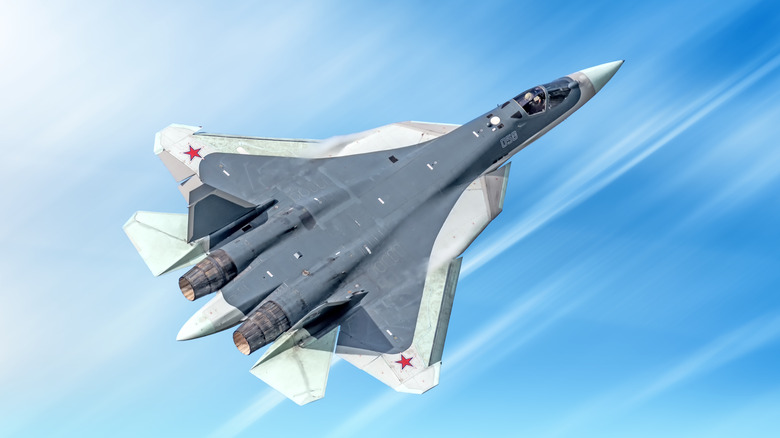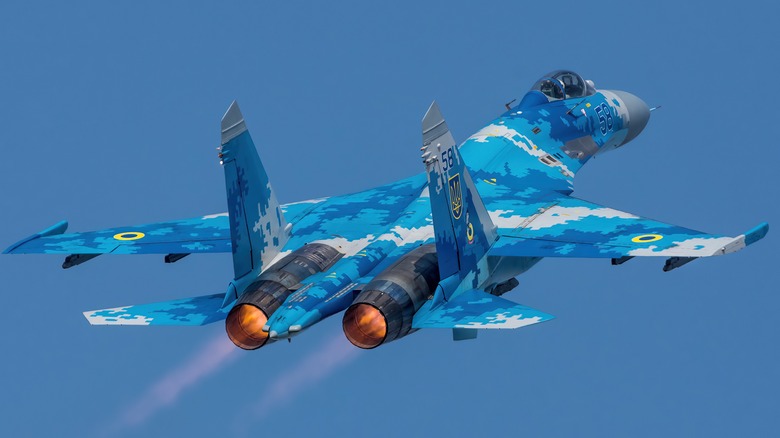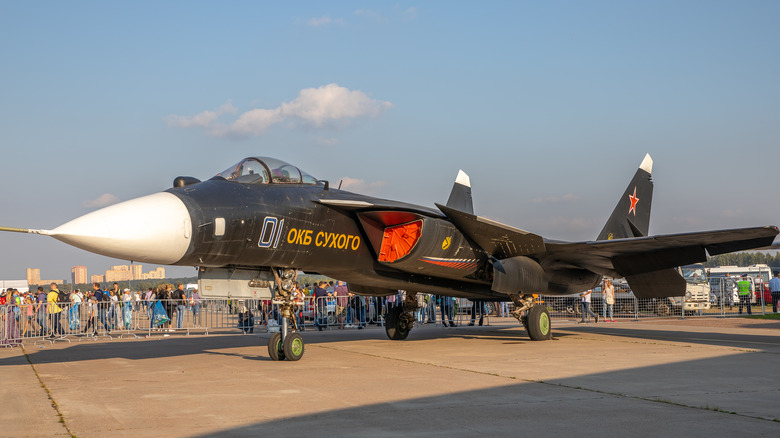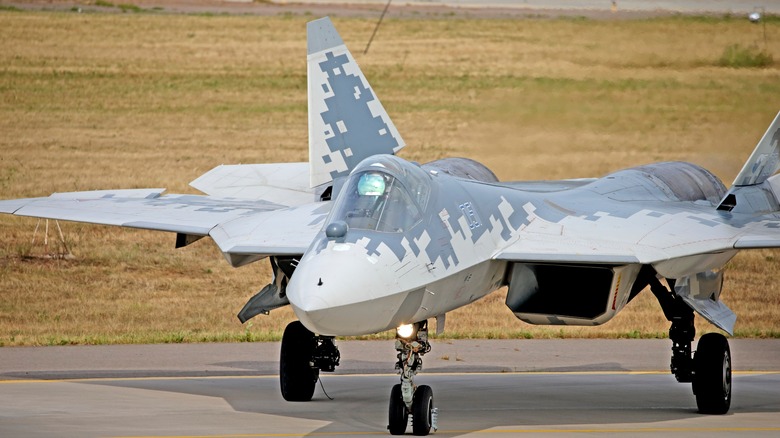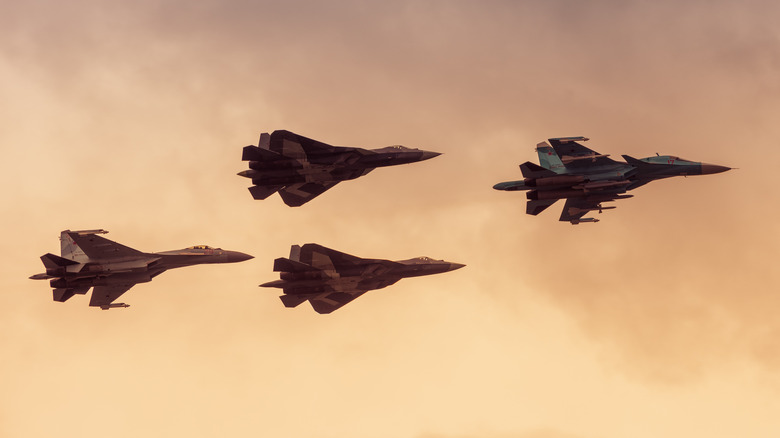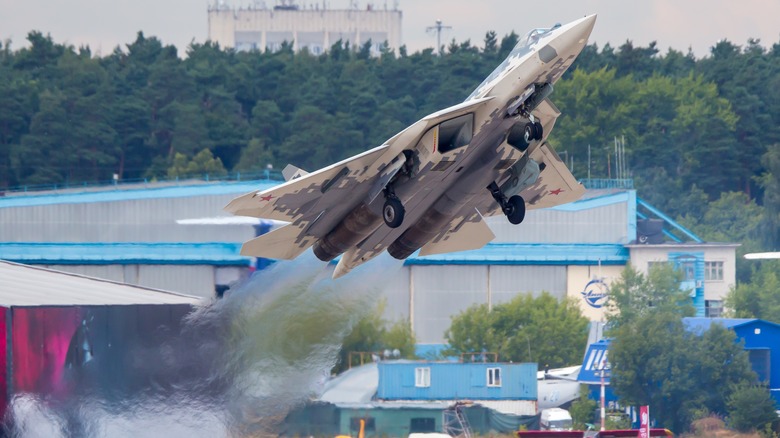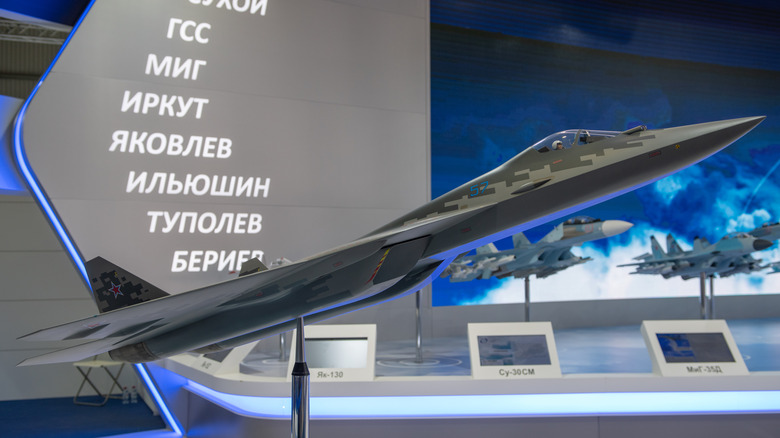Everything To Know About The Sukhoi Su-57 'Felon' Jet
The thing about technology manufacturing is that there's always someone out to imitate, undercut, or top your ideas. This is the case whether you're a games console maker or a manufacturer of military aircraft. In lots of cases, naturally, the militaries of the world want to keep the mightiest weapons to themselves, working in secret and keeping the likes of the formidable F-22 Raptor under wraps.
The threat posed to the United States by the Soviet Union, and vice-versa, has historically caused something of an arms race between the two. Each has felt the need, for instance, for a fighter jet that's a match for the best the other can field. The F-35 Lightning II is among America's greatest jets, while for Russia, the Sukhoi Su-57 is perhaps the most impressive fighter jet innovation to date.
Reportedly codenamed Felon by NATO, this jet has incredible capabilities. We'll take a close look at its origins, specs, weaponry, and intended roles, as well as what future deployment may look like for the Su-57.
Setting the scene for the Su-57
Around the turn of the 1980s, the Soviet Union's Ministry of Aviation Industry had the ambitious goal of modernizing the various branches of its air force. In the area of fighter planes specifically, the plan was dubbed Istrebítel-90, or Fighter of the 1990s. As the title would suggest, the ultimate aim was to develop, create, and field a cutting-edge fighter over the course of the next decade or so.
Needless to say, the 1990s were ultimately unkind to the Soviet Union (it ceased to be late in 1991), but that doesn't mean the efforts to develop a sophisticated new fighter were completely fruitless. In the face of the Advanced Tactical Fighter project in the United States, the Soviet Union tasked some of its most experienced aircraft manufacturers with the development of something rather special too.
For Mikoyan, that something was the Mikoyan Project 1.44. Only one prototype was built, but it was a unique and seemingly very capable aircraft. Armed with R-37 and R-73 missiles, plus a Gryazev-Shipunov GSh-30-1, it would have boasted the firepower to meet targets at all sorts of ranges, and its NPO Saturn AL-41 engines offered supercruise and a top speed of approximately 2,480 kmph. Inadequate funding led to the project being stalled for years, which allowed Sukhoi's Su series to steal the spotlight. The impressive Su-27 (pictured here) gave way to the Su-47, which made its debut flight in 1997 and heralded even greater advancements.
From Su-47 to Su-57
The Su-47 is armed with an even greater range of weapons, including R-77s, K74s, X-59Ms and KAB-500s. With this range of missiles, targets on the ground as well as in the air are in danger. Add the aircraft's agility to the equation (features like the unusual shaping of the radome help it to remain mobile and stable even at supersonic speeds), and the power of its Perm Aviadvigatel D-30F6 turboshafts, and it was an excellent choice for the PAK FA initiative, which again strove to create a fighter for the next generation. Sukhoi were chosen to helm it, and after only minor modifications of the Su-47, the T50 PAK FA Stealth Fighter would initially fly in 2010.
It would be some time before PAK FA, or Perspective Aviation Complex of Frontline Aviation, would receive the catchier, more familiar moniker by which it has come to be known. In August 2017, it was officially designated as the Su-57. At the time, the aim was reportedly to have it completed and enter service in 2019, in a modest batch of a dozen, before production began.
As is so often the case, then, the development of the Su-57 was a long and involved process, reliant upon building on the framework of the aircraft that came before it. The end result, however, is a jet fighter rather different than those of the United States, but no less potent for it.
The specs of the Su-57
Fifth-generation fighters, in a broad sense, are the most sophisticated models that modern technology currently allows for. As such, they're typically slated to replace existing aircraft as soon as possible. In the case of the F-35A Lightning II, for instance, the United States Air Force declares its F-16s to be an "aging fleet" in comparison. The only other nations that officially boast fifth-generation fighters are China (the J-20) and, of course, Russia with its formidable Su-57.
Being among such lofty company, then, you'd expect that the Su-57 would sport an impressive range of tech specs. The numbers really speak for themselves in that regard. The jet can climb 350 meters in a single second, fly at more than 65,500 feet, and maxes out at Mach 2 (around 1550 mph). All of this is powered by twin Lyulka 117S engines with a combined power output of 28,400 kg.
In terms of general performance, the Felon is more than competitive with the F-22 Raptor, Defence Street notes. It boasts a slightly wider flight range of 2,175 miles versus the Raptor's 1,840 miles, when considering their base models, and the Raptor is just slightly faster, capable of Mach 2.25. The Su-57's suite of weaponry, however, is rather different, and there's a good reason for this. Next, we'll take a look at the arsenal available to the Su-57.
The Su-57's weapons
The Su-57 boasts high agility, allowing it to keep pace with, or outflank, a range of different targets as its objectives may dictate. It's got to be able to manage those targets, however.
A wide scope of targets, naturally, demands a suitably varied arsenal of weapons, and the Felon boasts just that. Among its repertoire are Kh-38M and Kh-58UShKE missiles, R-37 Axeheads, and an GSh-30-1 autocannon. With armaments like these, the Felon can tackle armored ground targets such as tanks and opposing fighters in the air with equal skill, as well as sporting something of a close-range defensive weapon should the tables be turned on it.
Of course, aircraft in general can scarcely afford to leave a lot of unused room, and so storage is at a premium. Another goal with the Su-57, then, was to efficiently use any and all space to maximize the number of weapons it can carry at any one time. To achieve this, wing-mounted missiles are equipped, and there's a designated area inside the craft too. After all, there's no use having the potential of wielding multiple types of missiles if you don't have anywhere to store them.
It's crucial for the Felon to have these options, too, because its intended role is perhaps rather different from that of a more conventional fighter jet.
The role of the Su-57
This aircraft was seemingly designed not simply as a fighter (an aircraft typically deployed to combat other aerial targets), but as a versatile, sophisticated, and aggressive attack aircraft more generally. It's a multi-role machine, with the intention of mitigating the typical weaknesses of fighters and bombers (the latter of which really struggles to defend itself against speedy air-to-air attackers) while trying to maintain some of the targeted destructive power of both.
In this area, too, the Felon is a markedly different prospect from the American F-22. While the latter does sport prominent weapons to use against ground targets (AIM-9s and GBU-32 Joint Direct Attack Munitions among them), it does so in a role that differs from its primary objective of seizing and maintaining control of contested skies.
The Su-57, in short, is a different breed of fifth-generation fighter jet, one that has rather different aims and a lot still to prove. Let's take a look at what future deployment may look like for it.
Future deployment of the Su-57
In May 2019, Russian President Vladimir Putin announced that the Su-57 would be acquired in numbers larger than were initially thought possible. "The 2028 arms program stipulated the purchase of 16 such jets," Tass quotes him as saying, before noting that reductions in the cost of manufacture ultimately enabled the ordering of 76 Felons instead. It remains to be seen, however, whether this full complement of 76 of the aircraft will enter service within the timescale provided.
It's a relative newcomer on the scene, after all, with the AL-41F1 powerplant initially being used as a sort of stopgap until the secretive izdeliye 30 can be implemented. In December 2022, The EurAsian Times reported that the first Su-57s were being prepared to be deployed with the 23 IAP, or 23rd Fighter Aviation Regiment. Deliveries had also taken place before this, such as two models potentially arriving at a training facility in Lipetsk earlier that year.
In theory, the Su-57 is certainly a potent new-generation fighter worthy of the distinction, and its stealth leaning is a first for Russian aviation. Its development, however, has been long, and it continues (in-depth military tests are estimated to continue until approximately 2025). Its true potential remains unplumbed for now, though, and the way it stacks up against rivals remains theoretical.
